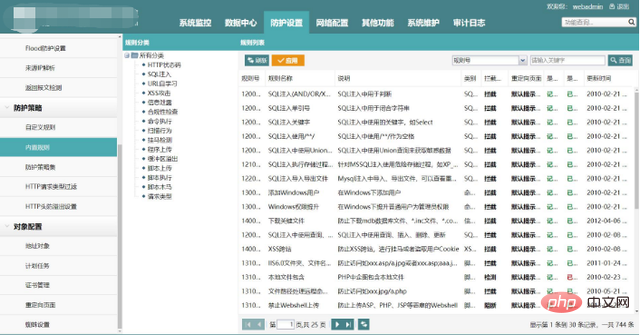What are the functions of computer networks
Computer networks have functions such as resource sharing, network communication, distributed processing, centralized management, and load balancing. Detailed introduction: 1. Resource sharing, including hardware resources, software resources, data resources and channel resources; 2. Network communication, which can transmit various types of information, including data information and graphics, images, sounds, video streams and other multimedia Information; 3. Distributed processing, dispersing the tasks to be processed to various computers instead of concentrating them on a large computer; 4. Centralized management, such as database information retrieval system, transportation department ticket booking system, etc.

The main purpose of computer network functions is to realize resource sharing between computers, network communication and centralized management of computers.

1. Resource sharing
(1)Hardware resources: including various types of computers, large-capacity storage devices, computer peripherals, such as color printers , electrostatic plotter, etc.
(2) Software resources: including various application software, tool software, support software for system development, language processing programs, database management systems, etc.
(3) Data resources: including database files, databases, office documents, enterprise production reports, etc.
(4) Channel resources: Communication channels can be understood as transmission media for electrical signals. The sharing of communication channels is one of the most important shared resources in computer networks.

2. Network communication
Communication channels can transmit various types of information, including data information and graphics, images, sounds, video streams, etc. Multimedia information.
3. Distributed processing
Distribute the tasks to be processed to various computers instead of concentrating them on a large computer. In this way, not only can the complexity of software design be reduced, but also work efficiency can be greatly improved and costs reduced.

4. Centralized management
When computers are not connected to the Internet, each computer is an "information island". When managing these computers, they must be managed individually. After computers are connected to the Internet, the entire network can be managed from a central location. Such as database information retrieval system, transportation department ticket booking system, military command system, etc.
5. Balancing load
When the task load of a certain computer in the network is too heavy, through the control and management of the network and application programs, the jobs will be distributed to other computers in the network. Completed by multiple computers.

The above is the detailed content of What are the functions of computer networks. For more information, please follow other related articles on the PHP Chinese website!

Hot AI Tools

Undresser.AI Undress
AI-powered app for creating realistic nude photos

AI Clothes Remover
Online AI tool for removing clothes from photos.

Undress AI Tool
Undress images for free

Clothoff.io
AI clothes remover

AI Hentai Generator
Generate AI Hentai for free.

Hot Article

Hot Tools

Notepad++7.3.1
Easy-to-use and free code editor

SublimeText3 Chinese version
Chinese version, very easy to use

Zend Studio 13.0.1
Powerful PHP integrated development environment

Dreamweaver CS6
Visual web development tools

SublimeText3 Mac version
God-level code editing software (SublimeText3)

Hot Topics
 1384
1384
 52
52
 What is an open network system in a communication network?
Aug 22, 2022 pm 02:17 PM
What is an open network system in a communication network?
Aug 22, 2022 pm 02:17 PM
The open network system is an "all-channel communication network." An all-channel communication network is an all-round open communication network system in which all members can communicate and contact each other without restriction; in this communication network, the degree of centralization is low and the status difference between members is small. With high morale, members can express their opinions directly, freely and fully, which is conducive to brainstorming and improving the accuracy of communication. The disadvantage is that it can easily lead to low work efficiency.
 Is the metropolitan area network a public network?
Aug 31, 2022 am 10:53 AM
Is the metropolitan area network a public network?
Aug 31, 2022 am 10:53 AM
The metropolitan area network is a public network; the metropolitan area network is a computer communication network established within a city, referred to as MAN, and is a broadband local area network. Due to the use of local area network technology with active switching elements, the transmission delay in the network is small. It can be used as a backbone network to connect hosts, databases, and LANs located in different locations in the same city to each other.
 What are the resource sharing functions of computer networks?
Jul 15, 2022 pm 04:29 PM
What are the resource sharing functions of computer networks?
Jul 15, 2022 pm 04:29 PM
The resource sharing functions of computer networks include: 1. Hardware resource sharing, which can improve equipment utilization and avoid repeated investment in equipment; 2. Software resource sharing and data resource sharing, which can make full use of existing information resources and reduce the software development process. to avoid repeated construction of large databases; 3. Communication channel resource sharing means that the same channel can be used by multiple users at the same time, which can improve the utilization of channel resources.
 What does a computer network system in a school belong to?
Jul 13, 2022 pm 04:43 PM
What does a computer network system in a school belong to?
Jul 13, 2022 pm 04:43 PM
A computer network system within a school is a local area network (LAN). A local area network is a network composed of multiple computers used in a small area. The coverage is usually limited to 10 kilometers. It belongs to a small-scale network established by a unit or department. LAN can be divided into wireless LAN and wired LAN. Wireless LAN can transmit audio, video, and text. Now many companies and campuses are using wireless LAN.
 What are the most prominent features of computer networks?
Jan 13, 2021 pm 03:13 PM
What are the most prominent features of computer networks?
Jan 13, 2021 pm 03:13 PM
The most prominent feature of computer networks is resource sharing. Resource sharing is one of the main purposes for people to establish computer networks. Usually, the resources required by multiple users at the same time always exceed the number of actual physical resources of the system. However, using logical (or virtual) resource allocation to realize resource sharing can better handle this contradiction and improve the efficiency of computer use.
 What are the topologies of computer networks?
Feb 22, 2023 am 11:30 AM
What are the topologies of computer networks?
Feb 22, 2023 am 11:30 AM
The topology of a computer network refers to the physical structure of nodes and lines formed by computers or equipment on the Internet and transmission media. It mainly includes star topology, bus topology, ring topology, tree topology, and hybrid topology. , network topology, switching power supply topology; among them, star network topology is the most widely used network topology.
 Why does a company use an intranet?
Aug 22, 2022 pm 03:57 PM
Why does a company use an intranet?
Aug 22, 2022 pm 03:57 PM
Reasons for using an intranet: 1. Resource sharing, which can provide convenient sharing of software and hardware resources, especially in the direction of hardware resources. Office automation equipment such as printers and scanners are fully utilized. 2. Facilitate teamwork. Most modern LANs provide a platform that allows multiple users to work on the same file and always use the latest version. 3. It is easy to find information, and the intranet can be used as a place to place all trusted information. 4. Reduce management costs. With the help of the intranet, online forms can be easily provided, streamlining the work process from the beginning, and greatly improving work efficiency.
 How to solve computer network connection error 711 in win7 system
Jul 17, 2023 am 08:41 AM
How to solve computer network connection error 711 in win7 system
Jul 17, 2023 am 08:41 AM
Many friends who use win7 system must have encountered the problem of network connection error 711. How to solve the problem of network connection error 711 in win7 system? Today, the editor will bring you a solution to the network connection error 711 on Windows 7 computers. How to solve the computer network connection error 711 in win7 system: 1. Open "Computer", find the "C:\Windows\System32\LogFiles folder, right-click and select Properties"; 2. Click "Security Options, select Advanced"; 3. Click "Owner", select "Edit"; 4. Select the account "aaa" currently in use and click OK; 5.



